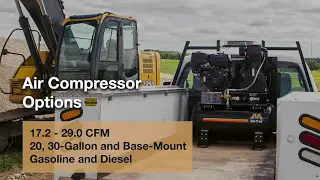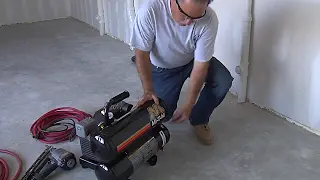We provide industrial air compressors from quality manufacturers. Our equipment is built for tough projects and will help you tackle even the biggest tasks.
Swift Industrial Cleaning Solutions proudly serves areas of Ohio, Indiana and Kentucky.
Swift Industrial Cleaning Solutions serves Ohio, Indiana and Kentucky. Below are some of the major cities we serve:
Don’t see your area? Contact us to see if we service your area!
In-Store Service
On-Site Service
Preventative Maintenance
What are the advantages of using compressed air vs. other power sources?
The advantages are many and are summarized in the following list:
Does a new compressor have to be broken in?
No, it does not. However after an install, you should power up the system from 0 to whatever the cut-off pressure is and check for any leaks that may be present.
What size of compressor do I need?
In order to determine what size compressor will meet your requirements you need to establish how it will be used. For example, if you will be using it to power air tools, then you need to determine the CFM of each tool. There are many applications for air compressors. If you need help deciding which size is best for you, please contact Mi‑T‑M at 800-553-9053 and we will be happy to assist you.
For applications involving less than 20 hours per week, a direct-drive system may be more appropriate. Direct-drive units spin at approximately twice the RPM of belt-driven counterparts. These units are often more compact, making them easier to transport. Additionally, they typically offer a more cost-effective solution for users with lighter usage needs.
How much air pressure do I need?
Air pressure is determined by the highest minimum pressure requirement. For example, some tools consume more air than others. Tools such as pneumatic nail-guns and staplers consume smaller amounts of air, while air grinders and sprayers consume larger amounts. Most tools have an usage rating for CFM consumption at a recommended PSI. This can be found on the tool itself or in the owner’s manual supplied by the tool manufacturer. Click here to view our Air Equipment Estimating Guide.
What is CFM and PSI and which is more important?
The notation CFM (Cubic Feet per Minute) refers to a volume of air produced by the air compressor at a given pressure or PSI (Pound per Square Inch). The right size air compressor will meet your needs in two essential areas: air flow (CFM) and pressure (PSI). It’s important to get a compressor that meets your needs in both areas – otherwise you risk damage to both your tools and the compressor itself. Always use CFM and PSI specifications from the nameplate on the product.
What is the difference between single and two stage pumps?
On a single stage pump the air is compressed one time and stored in a receiver. A two stage pump compresses the air twice, once in the first cylinder and then a second time in a smaller cylinder which gives you a higher CFM.
Can I install the compressor anywhere in my facility?
A reciprocating compressor is a very flexible piece of equipment but some cautions must be taken for an installation site selection. Refer to the instruction manual that is supplied with each unit. Some things to consider:
Can I install an air compressor in an outside location?
No, this is not recommended as the compressor unit must not come in direct contact with the elements. The best practice is to either put a lean-to over the unit or install it in a small building. If installed under a lean-to, we recommend a TEFC motor and NEMA 12 electrical enclosures. Also, when necessary cold weather protection for the oil and other lubricants is recommended.
How do I use compressed air that is stored at a higher pressure for my lower air pressure needs?
Install a pressure regulator that can be set for the required air pressure of the tool.
Why does my compressor run when I am not working or using compressed air?
There are a couple of things that could cause this:
Can you store more air at higher air pressures?
Yes, the higher air pressure will increase the amount of stored air. At 175 PSIG an 80 gallon tank will store 127 cu. ft. of air. The same 80 gallon tank at 100 PSIG will store only 73 cu. ft. of air.
Can I use PVC piping for my discharge air piping?
No, this is not up to the approved code for compressed air systems. The PVC is an oil based product and it does not react properly to heat, vibrations and oil vapor that is carried in the air compressor discharge air. The PVC is prone to bursting under the normal air pressure and unit operations. Consult your local building inspector for piping recommendations.
What type of oil should I use in the reciprocating compressor?
We recommend using non detergent oils that has been formulated for use in reciprocating compressors. DO NOT USE DETERGENT OILS in the compressor. The detergent oils will foam and cause excessive oil carryover past the piston rings and will not provide the required lubricity for the moving parts.
How do I automatically drain water out of my tank?
Install an automatic tank drain that is either air actuated, electronically actuated or timed sequence actuated.
How often should we change the oil?
For a Reciprocating air compressor, generally you would change the oil and the air filter approximately every 3 months. For a more accurate time frame, contact Mi-T-M at 800-553-9053 with your air compressor model number and we will help you find the recommended schedule for your compressor.
Can you tell me about the different options you offer for air compressors?
Starter: The starter is a magnetic device that induces electricity into the motor windings to energize them for work. The starter gets its signal from the pressure switch.
Pressure Switch: It measures the cut in and cut out pressure bands for the compressor start and stop settings and either turns the motor on or off as needed.
After Cooler: An after cooler is a device that uses air flow to cool the compressor discharge air temperature prior to being put into the tank for storage. This cooling function will drop out moisture that is in the compressed air.
Our team has sold and serviced air compressors near Cincinnati, Ohio for more than 20 years.
How To Use - Gas Compressor
Need tips on how to start and use an industrial gas air compressor? The video from the manufacturer helps with proper start-up, operation, and shutdown.

Watch Video
Service Vehicle + Air Compressor
Take the project on the road with compressors that can be easily mounted to your service vehicle or trailer. No matter what your industry is, we have a solution for you.

Watch Video
electric air compressor
Properly using your machine will keep it running longer and more efficiently. This video will provide useful tips for electric compressors.

Watch Video